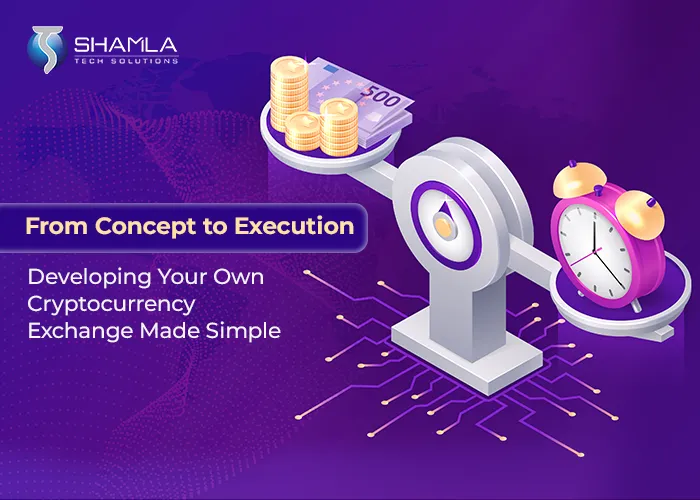In today’s digital age, embarking on the journey to develop cryptocurrency exchange opens up unparalleled opportunities within the dynamic realm of digital assets. Launch your cryptocurrency exchange to enter the rapidly evolving landscape of cryptocurrencies and blockchain technology. Whether you’re starting from scratch or customizing existing solutions, it involves navigating both technological challenges and regulatory requirements with precision and foresight to develop a cryptocurrency exchange. Cryptocurrency exchange development demands a strategic approach encompassing architecture, security, and user experience.
By leveraging robust frameworks and integrating advanced technologies, you can establish a solid foundation to create a cryptocurrency exchange. This comprehensive guide will walk you through the essential steps, from defining your business model to implementing rigorous security measures that will help you understand how to develop a cryptocurrency exchange. Explore the complexities and potentials to build your own cryptocurrency exchange, where innovation meets opportunity in the dynamic world of digital finance.

What is Cryptocurrency Exchange & How does it work?
A cryptocurrency exchange is a digital platform that facilitates the buying, selling, and trading of cryptocurrencies. It acts as an intermediary, matching buyers with sellers and providing a secure environment for transactions. Users can exchange various cryptocurrencies, such as Bitcoin, Ethereum, and others, often using fiat currencies like USD or EUR as well. These platforms typically charge fees for transactions, which can vary based on factors like trading volume and features offered. Cryptocurrency exchanges play a crucial role in the crypto economy by providing liquidity, price discovery, and accessibility to digital assets for investors, traders, and enthusiasts worldwide.
Cryptocurrency exchange development is the process of creating a robust platform that enables users to engage in digital asset transactions securely and efficiently. Whether you aim to build a crypto trading platform from scratch or develop crypto exchange software using existing frameworks, the endeavor requires meticulous planning and technical expertise. Here’s how cryptocurrency exchange platforms generally work:
Market Dynamics
Cryptocurrency exchanges operate on the principles of supply and demand, where users place buy (bid) and sell (ask) orders through an order book. This mechanism facilitates price discovery and enables efficient trading.
Order Matching
A sophisticated matching engine processes incoming orders in real-time, matching buy and sell orders based on predefined criteria such as price, quantity, and order type (market, limit, etc.). This ensures fair and timely execution of trades.
Security Measures
Due to the decentralized and digital nature of cryptocurrencies, security is paramount. Implementing crypto exchange architecture includes robust security protocols such as SSL encryption, two-factor authentication (2FA), and cold storage solutions to safeguard user funds and data.
Wallet Integration
Seamless crypto wallet integration is crucial for users to deposit, withdraw, and store their digital assets securely. Exchanges typically support a wide range of cryptocurrencies and fiat currencies, offering multiple wallets for flexibility.
Trading Pairs
Cryptocurrency exchanges offer various digital asset trading platform pairs, allowing users to trade between different cryptocurrencies (e.g., BTC/ETH) or between cryptocurrencies and fiat currencies (e.g., BTC/USD). This diversification enhances liquidity and market participation.
Fee Structures
Exchanges levy fees on transactions, which vary based on factors like trading volume, order type, and market conditions. Transparent fee structures contribute to the exchange’s revenue model and user experience.
Regulatory Compliance
Compliance with global regulatory standards, including KYC (Know Your Customer) and AML (Anti-Money Laundering) regulations, is essential. This ensures legal adherence and builds trust among users and stakeholders.
Types of Cryptocurrency Exchanges
Cryptocurrency exchanges come in various forms, each offering different features and catering to different user needs. Here’s a detailed look at the main types of cryptocurrency exchanges:
Centralized Exchanges (CEX)
Centralized exchanges are operated by a central authority or company, acting as intermediaries in cryptocurrency trading. Centralized exchanges offer high liquidity, facilitating large trading volumes and competitive pricing. They provide advanced trading features, including margin trading and various order types, catering to professional traders. These platforms typically have user-friendly interfaces and robust customer support, making them accessible to a wide range of users. By requiring KYC (Know Your Customer) verification, they ensure compliance with regulatory standards, enhancing trust and security for users and stakeholders alike.
Decentralized Exchanges (DEX)
Decentralized exchanges operate on blockchain technology without a central authority, enabling peer-to-peer trading. Decentralized exchanges prioritize security and user control, as users maintain custody of their funds through private keys. They offer enhanced privacy by minimizing the need for KYC verification, appealing to users seeking anonymity. DEXs foster trust through transparent, immutable transactions on the blockchain, reducing the risk of hacks and thefts associated with centralized platforms. These exchanges facilitate innovation in decentralized finance (DeFi), supporting a wide range of tokens and smart contract functionalities.
Hybrid Exchanges
Hybrid exchanges combine features of both centralized and decentralized models, offering flexibility and enhanced functionalities. Hybrid exchanges leverage centralized liquidity with decentralized security measures, providing a balanced approach to trading. They integrate advanced trading tools and multiple order types while allowing users to maintain control over their assets. By implementing hybrid architectures, these platforms enhance user experience and operational efficiency, adapting to regulatory requirements across different jurisdictions. Hybrid exchanges foster liquidity pools and market-making strategies, supporting diverse trading pairs and tokenized assets.
Peer-to-Peer Exchanges (P2P)
Peer-to-peer exchanges facilitate direct transactions between users without intermediaries, promoting privacy and accessibility. Peer-to-peer exchanges prioritize user privacy and peer-to-peer transactions, reducing reliance on centralized authorities. They offer flexible payment options and support for various cryptocurrencies, enabling global access to digital assets. P2P platforms enhance market liquidity by connecting buyers and sellers directly, facilitating competitive pricing and swift transaction settlements. These exchanges empower users with control over their trading activities and fund management, fostering a decentralized approach to cryptocurrency trading.
Instant Exchange Services
Instant exchange services enable quick and seamless cryptocurrency swaps without the need for user accounts or deposits. Instant exchange services offer convenience and efficiency by aggregating liquidity from multiple exchanges. They provide competitive exchange rates and instant transaction processing, minimizing the time required for cryptocurrency conversions. These services support a wide range of cryptocurrencies and fiat pairs, catering to users seeking rapid asset swaps and seamless trading experiences. Instant exchange platforms enhance market efficiency and accessibility, promoting broader adoption of digital assets globally.
When choosing an exchange, it’s important to consider factors such as security, liquidity, user experience, and the specific needs of your trading strategy.

How to develop a cryptocurrency exchange?
Cryptocurrency exchange development involves a structured process that integrates technical expertise, regulatory compliance, and user-centric design. Here’s a comprehensive guide on how to develop a cryptocurrency exchange.
Define Your Business Model and Goals
Before delving into technical aspects, it’s crucial to define your goals and business model to develop a cryptocurrency exchange. Determine whether you aim to cater to retail traders, institutional investors, or both. Consider your revenue model—whether through trading fees, listing fees, or other mechanisms—and outline your target market demographics. Understanding these elements will guide decisions throughout the cryptocurrency exchange development process.
Choose the Right Development Approach
There are several ways available to develop a cryptocurrency exchange.
- Build cryptocurrency exchange from scratch: This approach offers maximum customization and control over the platform’s features and architecture.
- Utilize white-label solutions: White-label solutions provide a pre-built framework that can be customized to fit your branding and functional requirements, reducing development time and costs.
- Customize existing open-source platforms: Platforms like OpenDAX, Binance Cloud, or Alpha Point offer open-source solutions that can be tailored to meet specific business needs while leveraging community-driven development.
By carefully evaluating these factors and understanding the pros and cons of each approach, you can make an informed decision that aligns with your business goals and sets the stage for a successful cryptocurrency exchange development.
Architectural Design and Infrastructure Setup
Cryptocurrency exchange development requires a robust architectural design to ensure scalability, security, and performance:
- Server Setup: Determine the server architecture suitable for handling high-frequency trading and high-volume transactions.
- Database Design: Design a database schema optimized for storing transactional data, user information, trading history, and account balances securely.
- API Integration: Integrate APIs for market data aggregation, order execution, KYC/AML verification, and payment gateways to facilitate seamless user experience and operational efficiency.
Implementing Security Measures
Security is paramount in cryptocurrency exchange development due to the decentralized and digital nature of cryptocurrencies:
- SSL Encryption: Secure all communications between users and the exchange platform to prevent interception and tampering of sensitive data.
- Two-Factor Authentication (2FA): Implement 2FA to add an extra layer of security during user logins and transactions.
- Cold Storage: Store the majority of user funds offline in cold wallets to protect against hacking and unauthorized access.
- Regular Security Audits: Conduct periodic security audits and penetration testing to identify and mitigate vulnerabilities proactively.
Develop the Trading Engine and User Interface
The heart of any cryptocurrency exchange is its trading engine and user interface:
- Trading Engine: Develop a high-performance matching engine capable of processing orders in real-time with minimal latency. Support various order types such as market orders, limit orders, and stop-limit orders.
- User Interface: Design an intuitive and responsive interface that provides traders with real-time market data, interactive charts, order book visibility, and a seamless trading experience across desktop and mobile devices.
Integrate Payment Gateways and Wallets
Facilitate easy deposits and withdrawals through robust payment gateways and secure cryptocurrency wallets:
- Payment Gateways: Integrate popular payment methods such as bank transfers, credit/debit cards, and digital wallets to enable fiat currency deposits and withdrawals.
- Cryptocurrency Wallets: Implement multi-currency wallets to support the storage and management of various cryptocurrencies securely. Ensure wallet integration includes features for address management, transaction tracking, and security protocols
Regulatory Compliance and Legal Considerations
Navigate the regulatory landscape and ensure compliance with local and international laws:
- KYC/AML Compliance: Implement robust Know Your Customer (KYC) and Anti-Money Laundering (AML) procedures to verify user identities and monitor transactions for suspicious activities.
- Licensing: Obtain necessary licenses and registrations from regulatory authorities to legally operate as a cryptocurrency exchange in your target jurisdictions.
Testing and Quality Assurance
Thoroughly test all aspects of your exchange platform to ensure functionality, security, and scalability:
- Functional Testing: Validate all features and functionalities to ensure they work as intended across different user scenarios.
- Security Testing: Conduct rigorous security testing, including penetration testing and vulnerability assessments, to identify and mitigate potential security risks.
- Performance Testing: Test the platform’s performance under simulated high-load conditions to assess scalability and reliability.
Launch Your Cryptocurrency Exchange
Launch your cryptocurrency exchange by creating a comprehensive marketing strategy:
- Pre-Launch Marketing: Generate buzz and attract early adopters through digital marketing campaigns, social media engagement, and partnerships with influencers in the cryptocurrency community.
- Customer Support: Provide robust customer support channels to assist users with on boarding, trading inquiries, and technical issues post-launch.
Monitor, Iterate, and Innovate
After launching your cryptocurrency exchange, monitor key performance indicators (KPIs), user feedback, and market trends:
- Continuous Improvement: Continuously iterate on the platform based on user feedback, technological advancements, and regulatory changes to enhance user experience and maintain a competitive edge.
By following these detailed steps, you can develop a cryptocurrency exchange that is secure, scalable, and user-friendly. It is a multifaceted journey that requires careful planning, strategic decision-making, and meticulous execution to create a cryptocurrency exchange. By understanding and following the steps outlined, from defining your business model and goals to implementing robust security measures and ensuring regulatory compliance, you can build a cryptocurrency exchange platform. By leveraging the insights and strategies shared in this guide, you can confidently navigate the complexities of cryptocurrency exchange development and position your platform for long-term success.

How do I exchange my cryptocurrency?
Exchanging cryptocurrency involves several detailed steps to ensure a smooth and secure transaction. Understanding these steps can help you navigate the process confidently. This comprehensive guide covers the necessary steps to start cryptocurrency exchange transactions efficiently.
1. Choose a Cryptocurrency Exchange Platform
Selecting the right exchange is crucial. Look for exchanges with a strong reputation and positive user reviews. Ensure the platform supports the cryptocurrencies you wish to trade. Security features are paramount, so check for measures like two-factor authentication (2FA), cold storage for funds, and regulatory compliance. Compare fees, including transaction fees, deposit/withdrawal fees, and other charges. Higher liquidity ensures faster transactions and more stable prices. A user-friendly interface can make the trading process more intuitive. Popular exchanges include Coinbase, Binance, Kraken, and Gemini.
2. Create an Account
Register on the chosen exchange by providing your email address, creating a strong password, and agreeing to the terms of service. Complete the KYC (Know Your Customer) process by submitting a government-issued ID, proof of address, and sometimes a selfie for identity verification. Enable 2FA to add an extra layer of security to your account using an authenticator app like Google Authenticator or Authy.
3. Deposit Your Cryptocurrency
On the exchange platform, navigate to the deposit section and select the cryptocurrency you want to deposit. The platform will generate a unique deposit address for you. Open your personal cryptocurrency wallet, select the cryptocurrency, and choose the option to send or transfer. Enter the deposit address provided by the exchange and specify the amount. After initiating the transfer, you may need to wait for the transaction to be confirmed on the blockchain. The number of required confirmations varies by exchange and cryptocurrency.
4. Select the Desired Trading Pair
A trading pair represents the two currencies you are trading between, such as BTC/ETH for trading Bitcoin for Ethereum. Check the current market rates, trading volume, and historical price charts to make informed decisions. When you build cryptocurrency exchange platform systems, ensure they support multiple trading pairs to attract more users.
5. Place an Order
Decide whether to place a market order, which executes immediately at the current market price, or a limit order, which executes only when the market reaches your specified price. A stop-limit order combines a stop order and a limit order, placing a limit order when the stop price is reached. Depending on your trading strategy, choose the order type that best suits your needs. Market orders are suitable for quick trades, while limit orders are better for precise pricing.
6. Confirm the Transaction
Double-check the amount, trading pair, and order type. Be aware of the fees associated with your order, as these can impact your net gains. Once confirmed, your order will be processed. Market orders are usually executed immediately, while limit orders will remain open until the market price meets your specified limit.
7. Withdraw the Exchanged Cryptocurrency
Generate a receiving address for the cryptocurrency you have exchanged in your personal wallet. On the exchange platform, navigate to the withdrawal section, enter the withdrawal address, and specify the amount to transfer. Complete any additional security steps required by the exchange, such as email confirmation or 2FA verification. After initiating the withdrawal, monitor the transaction status until it is confirmed on the blockchain and the funds appear in your wallet. When you develop cryptocurrency exchange platforms, ensure they have robust withdrawal security protocols.
8. Keep Track of Transactions
Maintain a detailed record of all transactions, including dates, amounts, fees, and transaction IDs. Cryptocurrency transactions may be subject to tax regulations in your jurisdiction, so proper documentation ensures compliance and simplifies tax reporting. Use portfolio tracking tools to monitor the performance of your assets over time. If you aim to start cryptocurrency exchange services, offering transaction history features can enhance user experience.
Exchanging cryptocurrency involves several detailed steps that require careful attention to security and transaction details. By following this comprehensive guide, you can navigate the process confidently and efficiently, ensuring your assets are traded safely and effectively. Stay informed about market trends and regulatory changes to optimize your trading strategy and protect your investments. If you are looking to launch your cryptocurrency exchange or create cryptocurrency exchange platforms, these steps highlight the importance of a user-centric and secure approach. It requires a blend of technical knowledge and an understanding of user needs to develop a cryptocurrency exchange.

Is Developing a Cryptocurrency Exchange Profitable?
Developing a cryptocurrency exchange can be incredibly profitable due to multiple revenue streams and the growing popularity of digital assets. However, profitability depends on several factors including market conditions, competition, user acquisition, and the overall execution of the business model. Start a cryptocurrency exchange to capitalize on the growing demand and opportunities in the digital currency market. Here’s an in-depth look at why and how developing a cryptocurrency exchange can be profitable:
Lucrative Revenue Streams
- Trading Fees: One of the primary revenue sources for cryptocurrency exchanges is transaction fees. These fees are charged on every trade executed on the platform. Depending on the exchange, these fees can range from 0.1% to 0.5% per transaction. High trading volumes can lead to significant revenue from transaction fees alone.
- Listing Fees: Exchanges can charge cryptocurrency projects a fee to list their tokens on the platform. This listing fee can be substantial, especially for exchanges with high traffic and a large user base. Projects are often willing to pay these fees to gain visibility and access to a broader audience.
- Withdrawal Fees: Exchanges typically charge a small fee when users withdraw their cryptocurrencies from the platform. This fee can vary based on the cryptocurrency and the amount being withdrawn. Over time, these fees can accumulate and contribute to the exchange’s revenue.
- Margin Trading and Lending: Offering margin trading and lending services can generate additional income through interest and fees, appealing to advanced traders seeking higher leverage.
- Premium Services: Many exchanges offer premium features such as advanced trading tools, enhanced security, and API access for a subscription fee, providing another source of revenue.
Growing Market Demand
- Increasing Adoption: The global adoption of cryptocurrencies is on the rise. More individuals and institutions are looking to invest, trade, and use digital assets, driving up the demand for user-friendly and reliable exchange platforms.
- Diverse Asset Offerings: By listing a wide variety of cryptocurrencies and tokens, exchanges can attract a broad user base, increasing trading activity and revenue.
Technological Advancements
- Advanced Features: Incorporating features like algorithmic trading, derivatives, and staking can attract sophisticated traders and boost trading volumes, enhancing profitability.
- Security Enhancements: Prioritizing security with multi-signature wallets, cold storage, and regular security audits builds user trust and attracts more users, ensuring steady growth.
Regulatory Compliance
- Navigating Regulations: Adhering to local and international regulations not only ensures legal operation but also builds credibility and attracts institutional investors, expanding the user base.
- Licensing: Obtaining licenses in multiple jurisdictions opens new markets and enhances user trust, further boosting the exchange’s reputation and profitability.
Competitive Edge
- Market Competition: Differentiating your exchange through unique features, superior user experience, and strong security measures helps attract and retain users in a competitive market.
- Brand Reputation: Building a reputable brand through transparent operations, excellent customer support, and active community engagement attracts more users and encourages loyalty.
Operational Efficiency
- Development and Maintenance: Investing in top-notch technology and security ensures a smooth and secure user experience, attracting more traders and increasing trading volumes.
- Marketing and Customer Acquisition: Effective marketing strategies, including digital marketing, partnerships, and promotions, attract a steady stream of new users.
Managing Market Dynamics
- Market Volatility: The inherent volatility of cryptocurrency markets can lead to increased trading volumes and revenue. Exchanges thrive on active trading, which is amplified by market movements.
- Security Measures: By investing in robust security protocols and insurance, exchanges can mitigate risks and build user confidence, attracting more users.
It is highly profitable to develop a cryptocurrency exchange, supported by the expanding global interest in digital assets. By leveraging multiple revenue streams, ensuring regulatory compliance, and offering a secure and user-friendly platform, exchanges can attract a large user base and generate substantial revenue. With the right approach, cryptocurrency exchange development can be a lucrative and sustainable business.

How much does it cost to develop a cryptocurrency exchange?
The cost to develop a cryptocurrency exchange can vary widely depending on several factors, including the development approach, features and functionalities, security measures, regulatory compliance, and the development team’s location and expertise. Cryptocurrency exchange development is a multifaceted endeavour start influenced by several key factors that shape its scope and complexity. The approach taken—whether building from scratch, utilizing white-label solutions, or customizing open-source platforms—determines the customization options, development timelines, and scalability capabilities of the exchange platform. Each approach has its advantages: building from scratch offers maximum flexibility in feature development and architecture, while white-label solutions provide a quicker time-to-market with reduced initial investment. Open-source platforms combine community-driven development with customization possibilities to tailor functionalities to specific business needs.
Key components to develop a cryptocurrency exchange include robust security measures, regulatory compliance, and user-friendly interfaces. Successful cryptocurrency exchange development also hinges on ongoing maintenance, scalability to accommodate increasing user bases, and strategic marketing to attract traders. It requires careful budgeting and planning across various stages to start a cryptocurrency exchange, from initial development to ongoing operational costs. Understanding these factors helps in estimating costs accurately and ensuring a successful launch aligned with your business objectives. Working with experienced developers and advisors can streamline the process and optimize costs while meeting regulatory requirements and market demands.
The total cost to develop a cryptocurrency exchange can range from tens of thousands to hundreds of thousands of dollars or more, depending on the complexity and scale of the project. It’s crucial to budget for development, security, compliance, operational, and marketing costs to ensure a successful launch and sustainable operation of the exchange in the competitive cryptocurrency market.
How Shamla Tech Can Help Develop Your Cryptocurrency Exchange
At Shamla Tech, we specialize in helping businesses develop cryptocurrency exchanges that are robust, secure, and tailored to meet unique needs. Our comprehensive cryptocurrency exchange development services cover every stage from concept to launch, ensuring seamless and successful deployment.
Custom Development Solutions
We offer customized solutions to develop cryptocurrency exchange platforms, ensuring scalability and performance. Whether you need to create your own cryptocurrency exchange in 2 days platforms from scratch or enhance existing ones, our team integrates cutting-edge technologies to deliver a competitive edge in the market.
Blockchain Expertise
With our deep understanding of blockchain technology, we build cryptocurrency exchange platforms that leverage decentralized architectures. This includes integrating smart contracts and blockchain protocols to enhance security, transparency, and operational efficiency. Our expertise in blockchain technology allows us to develop cryptocurrency exchange platforms that are both secure and efficient.
Security Protocols
We prioritize the security of your platform, implementing rigorous protocols and conducting comprehensive audits to ensure your exchange is resilient against cyber threats. By focusing on robust security measures, we help develop cryptocurrency exchange platforms that safeguard users’ assets and data.
Compliance and Regulation
Navigating the regulatory landscape is crucial for any cryptocurrency exchange. We provide expert guidance on compliance requirements, including KYC/AML protocols, to ensure your platform meets global regulatory standards. Our compliance solutions mitigate legal risks and enhance credibility, helping you start cryptocurrency exchange operations smoothly.
UI/UX Design
We focus on creating intuitive and engaging user interfaces (UI/UX) that enhance user experience and usability. Our designs are crafted to optimize user engagement and facilitate seamless trading experiences, ensuring that the platforms we help develop cryptocurrency exchange remain user-friendly and accessible.
Support and Maintenance
From the initial stages to ongoing support, we offer continuous maintenance and technical assistance to ensure your platform operates smoothly. Our dedicated team is available to address your needs and optimize your platform for long-term success, making sure your cryptocurrency exchange development is a seamless process.
Partnering with Shamla Tech to develop cryptocurrency exchange platforms means gaining access to a seasoned team of experts committed to delivering innovative solutions. Whether you aim to create your own cryptocurrency exchange in 2 days platforms or enhance their capabilities, we are here to empower your vision and drive success in the dynamic world of digital assets. Our expertise in cryptocurrency exchange development ensures that your platform will be competitive, secure, and efficient.

